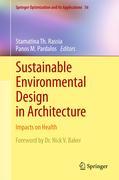
Sustainable environmental design in architecture: impacts on health
Rassia, Stamatina T.
Pardalos, Panos M.
Over the last few decades, there have been dramatic improvements in the understanding and research of environmental design. Numerous methods have been developed to enhance architectural design in order for it to be more energy efficient, sustainable and health enhancing. This book presents several theories andtechniques that can be used to improve how buildings are engineered and designed in order to utilize more sustainable construction methods while promoting the health of the building's occupants. Contributions to the study of environmental design have come from a diversity of fields including applied mathematics, optimization, computer science, medical research, psychology, management science, architecture, and engineering. The techniques developed in these areas of research can be used to increase building performance, occupant satisfaction, productivity, and well being, and reducing the incidence of health conditions and chronic diseases related to the use of a designed space. This book provides architectural practitioners, civil engineers as well as other interdisciplinary researchers with the techniques needed to design, implement, and test for sustainability and health promotion in new or existing structures. Contributed articles are devoted to recent interdisciplinary works in a variety of subjects related to sustainable architecture and engineering, environmental modeling, behavioral science and public health. Can be used as a supplemental text in a course focusing on Environmental Design in Architecture, Sustainable Building Design, Civil Engineering, Urban Development, Public Health, or Epidemiology. Topics presented will appeal to a wide readership within the scientific community. INDICE: 1. Sustainability and Neuroscience (J.P. Eberhard). 2. Behavioral Science Perspectives on Designing the Environment to Promote Child Health (M.E. Sharff, E. Gerfen, K.P. Tercyak). 3. Form Follows Function: Bridging Neuroscience and Architecture (E.A. Edelstein, E. Macagno). 4. Active Transport, Building Environment and Human Health (T. Sugiyama, M. Neuhaus, N. Owen). 5. Environmental Control and the Creation of Wellbeing (S. Manchanda, K. Steemers). 6 Design of Healthy, Comfortable Energy Efficient Buildings (C.A. Roulet, P. Bluysssen, B. Muller, E. de Oliveira Fernandes). 7. Environmental and BehaviouralFactors Affecting Residential Air Conditioning use in Athens and London (L. Chatzidiakou, A. Pathan, A. Summerfield, D. Mumovic). 8. The Influence of Weather Conditions on Pedestrians’ Behaviour and Motion, with Respect to Queues in Outdoor Urban Areas (I. Tzouvadakis, A. Stamos). 9. The Health of Informal Settlements Illness and Thermal Conditions (M. French, J. Gardner). 10. Live Urbanism, Towards Sensible Cities and Beyond (B. Resch, R. Britter, C. Ratti). 11.Computer aided Analysis of Pedestrians’ Motion Behaviour Using Video Frames Live Urbanism (I. Tzouvadakis, A. Stamos, D. Vassilaki). 12. Sustainable schedule of Hospitals Duffle Coat theory (W. Fawcett). 13. Philosophy About the Quality of our Indoor Climate (L. de Ruijsscher). 14. Impacts on Health: Variety of Problems and Problems of Variety (M. Samimi, M.Y. Nili, S. Seifi). 15. Forming Building Blocks Diplomacy Yield Innovative Solutions (W.French and S. Meyer). 16. Advantages of the Vertical Farm (D. Despommier). 17. Restoration-Preservation in an Urban Environment and Seismic Stability of the Statues of Athena and Apollo on the Forefront of the Academy of Athens (A. Kounadis, N.Makris). 18. A Health Damage Pattern Due to Street-Level Pollution in the Central ParisArea Estimated with the Turbulence-Resolving Model (I. Esau). 19. Les ecoquartiers en France (P. Lefevre).-.
- ISBN: 978-1-4419-0744-8
- Editorial: Springer New York
- Encuadernacion: Cartoné
- Páginas: 367
- Fecha Publicación: 28/11/2011
- Nº Volúmenes: 1
- Idioma: Inglés
